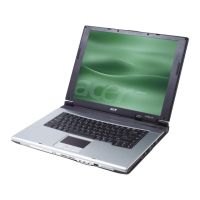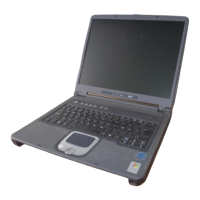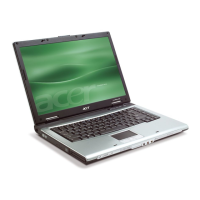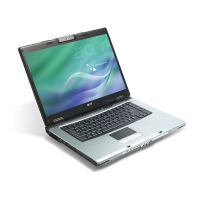
Do you have a question about the Acer TravelMate 2300 and is the answer not in the manual?
| Graphics | Intel Extreme Graphics 2 |
|---|---|
| Wireless | 802.11b/g |
| Card Reader | No |
| Battery Life | Up to 3 hours |
| Processor | Intel Pentium M or Intel Celeron M |
| Processor Speed | Up to 1.7 GHz |
| RAM | Up to 2 GB DDR |
| Storage | 40 GB HDD |
| Display | 15-inch TFT |
| Maximum Resolution | 1024 x 768 |
| Optical Drive | DVD-ROM/CD-RW Combo |
| Networking | 10/100 Ethernet |
| Ports | 3 x USB 2.0, VGA, Parallel |
| Battery | Li-Ion |
| Operating System | Windows XP Home |
Summary of the computer's performance specifications and features.
Details about the TFT LCD panel, resolution, and graphics capabilities.
Information on audio and optical drive features.
Lists available ports and communication interfaces.
Describes the design, appearance, and user comfort features.
Details about the keyboard layout and pointing device.
Information on expansion slots and memory upgrades.
Lists all available input/output ports on the computer.
Identifies connectors and components visible from the top of the motherboard.
Identifies connectors and components visible from the bottom of the motherboard.
Illustrates and describes the external features when the laptop is open.
Identifies and describes external features when the laptop is closed.
Identifies and describes components on the left side of the laptop.
Identifies and describes ports and features on the right side of the laptop.
Identifies and describes ports and features on the rear side of the laptop.
Identifies and describes components on the bottom of the laptop.
Explains the function of Caps Lock, Num Lock, and Scroll Lock keys.
Details how to use the embedded numeric keypad for data entry.
Explains the functions of Windows-specific keys.
Describes essential shortcut key combinations for system controls.
Explains how to type special characters like Euro and Dollar signs.
Describes the function of dedicated launch keys for applications.
Explains basic operations like moving cursor, clicking, and scrolling.
Details CPU types, speeds, and package information.
Details memory controller, size, sockets, speed, and combinations.
Specifications for 14.1-inch LCD panels.
Specifications for 15-inch LCD panels.
Specifications for the AC adapter.
Information on accessing and navigating the BIOS setup utility.
Instructions for navigating BIOS menus and changing parameters.
Describes the Main screen of the BIOS setup utility.
Describes the Advanced menu in BIOS for hardware settings.
Details BIOS security settings for user and supervisor passwords.
Step-by-step guide to setting user and supervisor passwords in BIOS.
Describes BIOS settings for boot device order.
Explains options for saving or discarding BIOS changes and exiting setup.
Essential steps and precautions before starting disassembly.
Provides a visual guide to the component removal sequence.
Step-by-step instructions for removing the battery pack.
Instructions for removing HDD, Memory, WLAN, Thermal Module, and CPU.
Instructions for removing the Optical Disc Drive and LCD modules.
Procedures for separating the main unit into upper and lower case assemblies.
Instructions for disassembling the upper case assembly.
Instructions for disassembling the lower case assembly.
Step-by-step instructions for disassembling the LCD module.
Instructions for removing the HDD and Optical Drive modules.
Instructions for removing the HDD module from its bracket.
Instructions for removing the optical drive module and its holder.
Diagnostic steps for checking drives, keyboard, memory, and system.
Steps to verify power issues using battery and AC adapter.
Detailed steps for checking battery health and charging operation.
Steps to troubleshoot touchpad functionality issues.
Guide to Power-On Self-Test error messages and their causes.
Lists error messages and their corresponding FRU/Action sequences.
Lists BIOS beep codes and their POST routine descriptions.
Maps symptoms to FRU replacement actions.
Procedures for analyzing and resolving intermittent system issues.
Procedures for isolating failing FRUs when the problem is not clearly identified.
Steps for performing disk-to-disk system recovery.
Identifies jumper and connector locations on the top side of the motherboard.
Identifies jumper and connector locations on the bottom side of the motherboard.
Provides a visual breakdown of system components for parts identification.
Lists Field Replaceable Units for the TravelMate 4000 series.
Lists AC adapters and batteries for the TravelMate 4000.
Lists boards and CPU options for the TravelMate 4000.
Lists optical disc drive modules for the TravelMate 4000.
Lists available hard disk drives for the TravelMate 4000.
Lists available keyboards for the TravelMate 4000.
Lists available LCD modules and related parts for the TravelMate 4000.
Lists available memory modules for the TravelMate 4000.
Lists various types of screws used in the TravelMate 4000.
Defines configurations for the TravelMate 4000 series models.
Lists tested components and specifications for Windows XP Pro.
Lists tested processor models and memory modules with specifications.
Lists tested LCD panels and their specifications.
Lists tested Hard Disk Drives and Optical Drives.
Lists tested ports like CRT, Parallel, USB, PC Card.
Lists tested memory cards (MMC, CF, MS, SD).
Lists tested audio jacks, speakers, headphones, and microphones.











